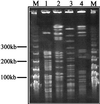Comparative genetic analysis of Mycobacterium ulcerans and Mycobacterium marinum reveals evidence of recent divergence
- PMID: 11053375
- PMCID: PMC94777
- DOI: 10.1128/JB.182.22.6322-6330.2000
Comparative genetic analysis of Mycobacterium ulcerans and Mycobacterium marinum reveals evidence of recent divergence
Abstract
Previous studies of the 16S rRNA genes from Mycobacterium ulcerans and Mycobacterium marinum have suggested a very close genetic relationship between these species (99.6% identity). However, these organisms are phenotypically distinct and cause diseases with very different pathologies. To investigate this apparent paradox, we compared 3,306 nucleotides from the partial sequences of eight housekeeping and structural genes derived from 18 M. ulcerans strains and 22 M. marinum strains. This analysis confirmed the close genetic relationship inferred from the 16S rRNA data, with nucleotide sequence identity ranging from 98.1 to 99.7%. The multilocus sequence analysis also confirmed previous genotype studies of M. ulcerans that have identified distinct genotypes within a geographical region. Single isolates of both M. ulcerans and M. marinum that were shown by the sequence analysis to be the most closely related were then selected for further study. One- and two-dimensional pulsed-field gel electrophoresis was employed to compare the architecture and size of the genome from each species. Genome sizes of approximately 4.4 and 4.6 Mb were obtained for M. ulcerans and M. marinum, respectively. Significant macrorestriction fragment polymorphism was observed between the species. However, hybridization analysis of DNA cleaved with more frequently cutting enzymes identified significant preservation of the flanking sequence at seven of the eight loci sequenced. The exception was the 16S rRNA locus. Two high-copy-number insertion sequences, IS2404 and IS2606, have recently been reported in M. ulcerans, and significantly, these elements are not present in M. marinum. Hybridization of the AseI restriction fragments from M. ulcerans with IS2404 and IS2606 indicated widespread genome distribution for both of these repeated sequences. Taken together, these data strongly suggest that M. ulcerans has recently diverged from M. marinum by the acquisition and concomitant loss of DNA in a manner analogous to the emergence of M. tuberculosis, where species diversity is being driven mainly by the activity of mobile DNA elements.
Figures






References
-
- Baess I, Mansa B. Determination of genome size and base ratio on deoxyribonucleic acid from mycobacteria. Acta Microbiol Scand Sect B Microbiol. 1978;86B:309–312. - PubMed
-
- Barker D J. Epidemiology of Mycobacterium ulcerans infection. Trans R Soc Trop Med Hyg. 1973;67:43–50. - PubMed
-
- Behr M A, Wilson M A, Gill W P, Salamon H, Schoolnik G K, Rane S, Small P M. Comparative genomics of BCG vaccines by whole-genome DNA microarray. Science. 1999;284:1520–1523. - PubMed
-
- Bellgard M I, Gojobori T. Significant differences between the G+C content of synonymous codons in orthologous genes and the genomic G+C content. Gene. 1999;238:33–37. - PubMed
-
- Bhatt A, Kieser T. Transposition of IS117 of Streptomyces coelicolor A3(2) in Mycobacterium smegmatis. Microbiology. 1999;145:1201–1207. - PubMed
Publication types
MeSH terms
Substances
Associated data
- Actions
- Actions
- Actions
- Actions
LinkOut - more resources
Full Text Sources
Other Literature Sources
Molecular Biology Databases
Miscellaneous

